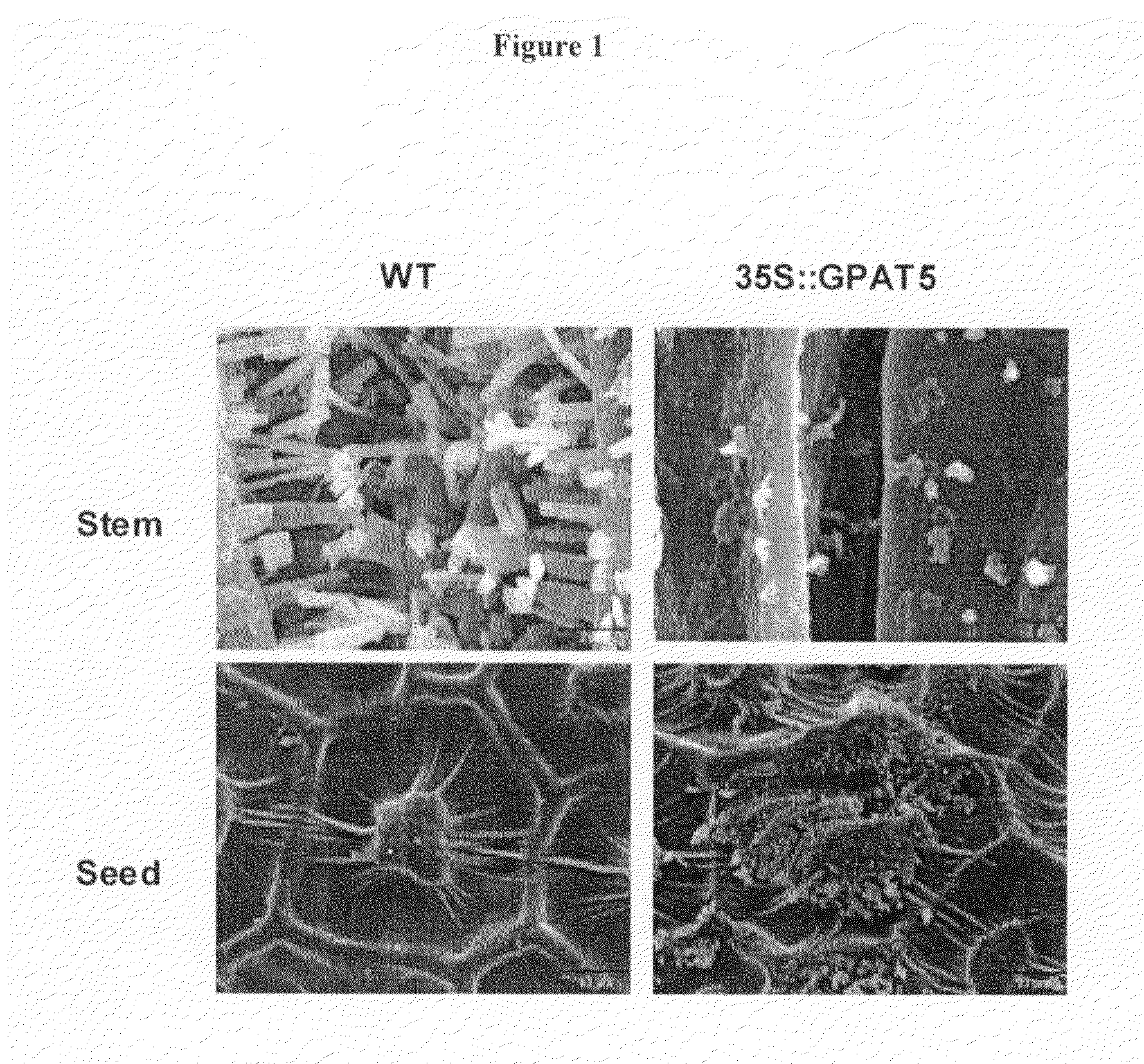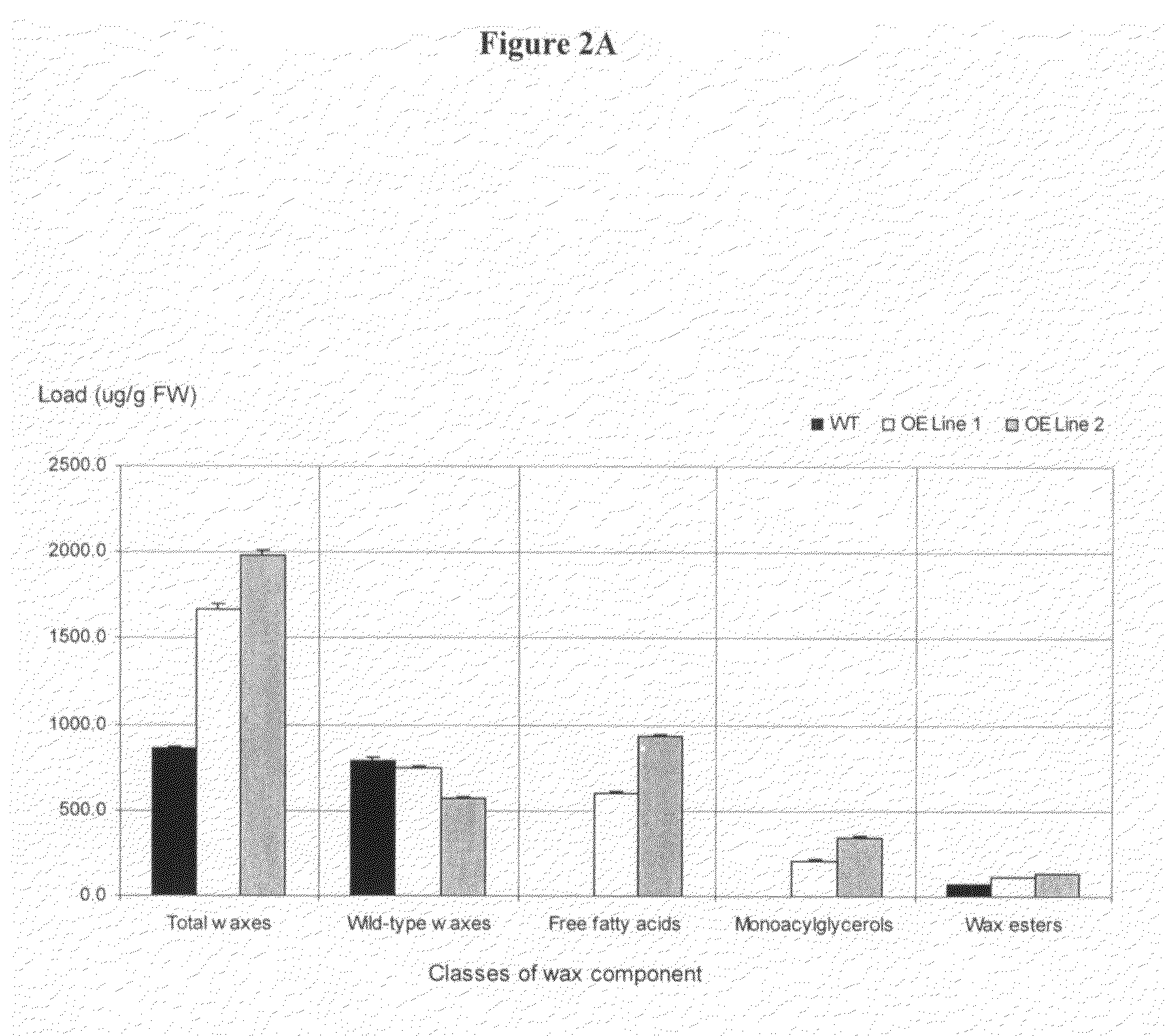Compositions and methods for using acyltransferases for altering lipid production on the surface of plants
a technology of acyltransferase and acyltransferase, which is applied in the field of compositions comprising acyltransferase nucleic acid molecules for altering lipid production on the surface of plants, can solve the problems of limited alterations in seed oil, limited commercial use of genetically modified plants, and high cost, so as to increase the activity of acyltransferase, increase the amount of free fatty acids, and increase the surface lipid
- Summary
- Abstract
- Description
- Claims
- Application Information
AI Technical Summary
Benefits of technology
Problems solved by technology
Method used
Image
Examples
example i
[0326]This example describes general materials and methods used in the development of the present inventions.
[0327]Plant Materials and Growth Conditions. Arabidopsis thaliana plants were ecotype Columbia-0 (Col-0), GPAT overexpression Arabidopsis thaliana plant lines (OE-1 and OE-2) were on the Col-0 background, and gpat T-DNA knockout lines (gpat5-1 and gpat5-2) were on the Columbia-0 background. The gpat5-1 and gpat5-2 mutants were isolated and characterized as described herein and in Beisson et al. ((2007) Plant Cell 19: 351-368; herein incorporated by reference).
[0328]Arabidopsis plants were grown in a controlled growth chamber at 21-22° C., 40-60% relative humidity (RH), under a 16 / 8 h light / dark cycle (photoperiod) a light intensity of 80-100 μmol m−2 s−1 provided by fluorescent bulbs. Plants were grown in pots on a soil mixture (1:1:1 mixture of peat moss-enriched soil:vermiculite:perlite) or on solidified agar sucrose medium containing MS salts (Murashige and Skoog, 1962, Ph...
example ii
[0347]This example describes extraction and recovery of free fatty acids, acylglycerols and other hydrocarbon derivatives from transgenic plants and plant parts such as stems and seeds.
[0348]Cuticular Wax Analysis. Stems were dipped in chloroform for 30 s, the solvent evaporated under a stream of N2 gas, and tricosane, tricosanoic acid, monoheptadecanoin and tridodecanoin added as internal standards. The waxes were derivatized by heating at 110° C. for 10 min in pyridine:BSTFA (N,O-bis-(trimethylsilyl)trifluoroacetamide) (1:1, v / v). The silylated sample was analyzed by GC using a 30 m DB5-ht capillary column temperature programmed at 10° C. min-1 to 370° Celcius. Eluate components were quantified based on uncorrected peaks areas resulting from an integrated FID ion current. For molecular identification, a Hewlett-Packard 5890 GC-coupled MSD 5972 mass analyzer was used, with the mass analyzer set in electron impact mode (70 eV) and scanning from 40-700 atomic mass units (amu).
[0349]T...
example iii
[0355]This example describes the materials and methods used in generating transgenic plants of the present invention. This example further describes creating and analyzing plants with overexpressed GPAT5 using an exemplary constitutive promoter, CaMV35S.
Cloning of GPAT5 and Construction of 35S::GPAT5 Overexpression Plants.
[0356]Genomic DNA was prepared from Arabidopsis leaf tissue using a Plant miniDNA kit according to manufacturer instructions (Qiagen). Genomic DNA sequences encoding a GPAT5 gene (see, genomic At3g11430 SEQ ID NO:1) were amplified by PCR using forward primer [5′-CACACTCTAGAATGGTTATGGAGCAAGC-3′ (underlined as added XbaI restriction site) SEQ ID NO:68] and reverse primer [CACACGAGCTCTCAATGGAGACAAGG (underlined as added SacI restriction site) SEQ ID NO:69]. The PCR product was initially cloned into pGEM-T easy vector (pGEM®-T Easy Vector Systems Technical Manual No. 042 Revised June 1999), and then subcloned as an XbaI-SacI fragment into binary vector pBI121 (accessio...
PUM
 Login to View More
Login to View More Abstract
Description
Claims
Application Information
 Login to View More
Login to View More - R&D
- Intellectual Property
- Life Sciences
- Materials
- Tech Scout
- Unparalleled Data Quality
- Higher Quality Content
- 60% Fewer Hallucinations
Browse by: Latest US Patents, China's latest patents, Technical Efficacy Thesaurus, Application Domain, Technology Topic, Popular Technical Reports.
© 2025 PatSnap. All rights reserved.Legal|Privacy policy|Modern Slavery Act Transparency Statement|Sitemap|About US| Contact US: help@patsnap.com



